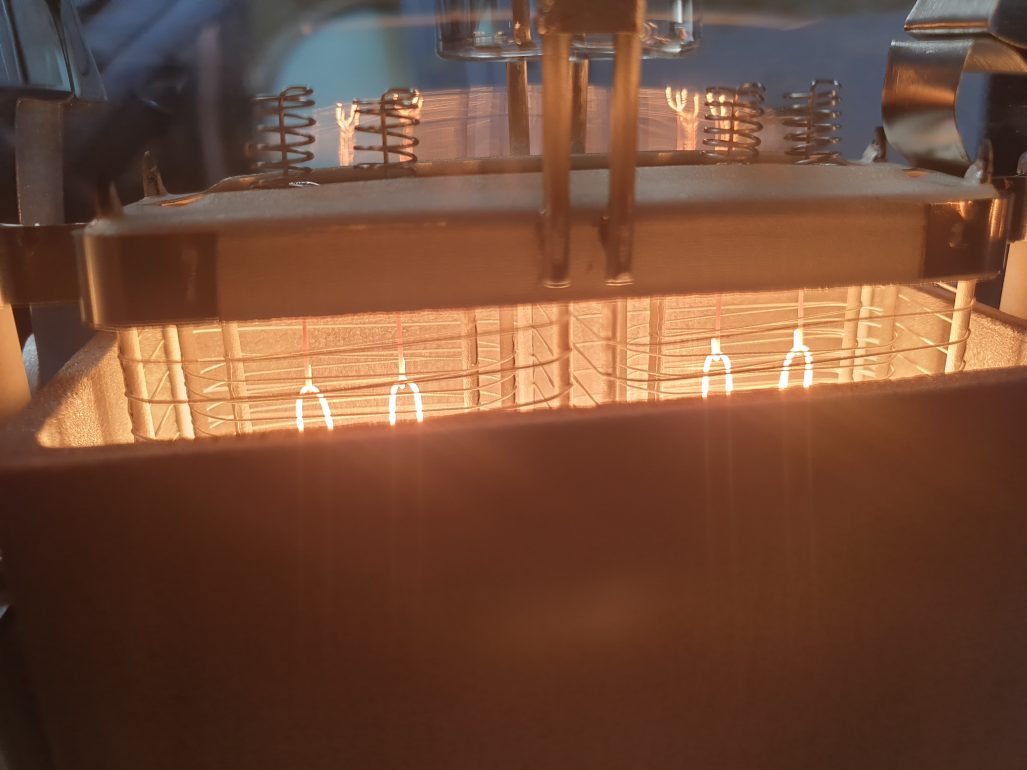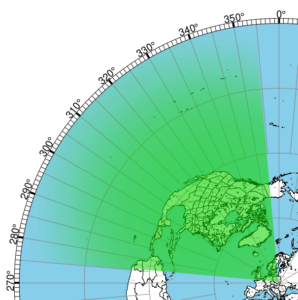Ten serwer WebSDR zbudowany jest z użyciem dedykowanego do tego celu serwera (i5-3470 CPU @ 3.20GHz z 8GB pamięci). Odbiornik aktualnie jest jeden – SDRplay RSP1A. Po ostatniej aktualizacji dostępne są dwa trzy odbiorniki – SDRplay RSP1A dla pasma 80m oraz dwa RTL-SDR V3 obsługujące pasmo 160m i 40m. Do odbiorników podłączona jest oddalona o około 60m od najbliższych zabudowań antena LoG (Loop On Ground – pętla leżąca bezpośrednio na gruncie) o boku około 6m.
Aktualnie odbiornik sprzętowy jest tylko jeden , natomiast z niego Z każdego z odbiorników równolegle korzystają dwa programy – websdr od PA3FWM oraz OpenwebRX. OpenwebRX ma świetną funkcję – dekodowanie FT8 i raportowanie do pskreporter. OpenwebRX niestety w porównaniu do websdr od PA3FWM ma gorsze audio. Chciałem mieć dostępne obie funkcje – zarówno dobre audio jak i dekodowanie. Udało się to zrobić dzięki programowi rtl_mus, który działa jak proxy dla rsp_tcp (odpowiednik rtl_tcp dla RSP1A).
Przez pewien czas dostępne było przełączanie pasm – 40m za dnia, 80m – w nocy. Powoli zaczynam wprowadzać docelową konfigurację, w której każde pasmo będzie miało swój dedykowany odbiornik – z tego powodu aktualnie dostępne jest tylko pasmo 80m.
In the future, additional receivers and switchable antennas will be available. This is a hobby, an amateur project and it all takes time and money. So please be patient.
- As of January 1, 2022, great DSP filters made by the Northern Utah WebSDR team are available :).
- On January 12th server was upgraded to a 150/150 MBit fiber-optic internet connection - this allows for simultaneous YT Live of radio meteor observations together with uninterrupted operation of websdr, more bands will be added soon
- UPDATE: on the same day, I managed to add the 40m band with reporting to pskreporter 🙂
, some corrections are still needed in mobile versions - 14th January – I've added dxcluster spots from SP2PUT dxcluster
- January 18/19 - from now on, user will start on main page with all bands by default, in addition, there are subpages - separate for each band. In near futur logged in users will be able to switch the receiving antennas here - on each band it will be possible to choose a different direction - the possibility of changing the direction will be independent of the receiver
- January 24th - I've added another band - 160 m 🙂
- Feb 5th - so far, the W7IUV preamp has been supporting receiver for 160m. Recently, after significant snowfall, I came to the conclusion that switching the preamp to the divider input may be a better solution. On 160m the changes should be almost unnoticeable, while on 80m and 40m the changes should already be significant.
- February 6th - as of today, websdr is available in pRxTx 🙂 app
- February 18th - cleanup of cabling and improvement of the grounding. According to what I wrote in grounding entry - around the feed point of the transmitting antenna on the ground I have (currently already overgrown with grass) welded galvanized mesh. My last inspection showed that, unfortunately, the solder joints are loose in some places. I started to fix it. Details soon in the new entry.
- 18/19 February - I added 60 m band for tests
- February 24 - the 60m band has been moved down a little bit, to make The Buzzer/UVB-76 available for listening
- March 3rd - I improved site layout and added greyline map
- March 23 - antenna was moved to another location, it was replaced with a larger loop. So far it was a 6×6 m loop, now it is about 12×12 m, so the antenna area is 4x larger. This will result in higher signal levels and better DX reception (which is already visible on pskreporter).
- April 19/20 - maintenance activities - tidying up cables, replacing one of the hard drives (after rebuilding the array, another drive will be replaced in the near future) and installing sound cards that will handle VLF, 630 m and 2200 m bands 🙂
- May 11 - feeder for the loop has been shortened to the necessary minimum (so far the antenna changed its size and location several times - to keep flexibility in these changes - there was much more cable than needed - so that the antenna could be easily moved to different locations. Currently the antenna is in its final location, so the feeder can be shortened to the required length). There will be other, quite significant changes soon, but I will inform about them in the next posts.
- June 20 - I've added a contact form to quickly notify me about problems on the site - some receiver stops receiving, or it's playing not what it should be - please write a message. Such message should reach me in theory - within a minute 🙂 .
- 23 czerwiec – uruchomiony testowo odbiornik qo-100. Aktualnie jest to wersja przejściowa – będzie jeszcze poprawiana. Wzrośnie poziom sygnału i S/N. Robię różne przemeblowania na działce związane m.in. z moimi krótkofalarskimi projektami. Lokalizacja, gdzie stoi antena i tak miała powstać i tak miał tam być wmurowany słupek. Gdy słupek już był… szkoda by było, by nie zawisła na nim taka spora antena 😉
- July 14 - I've added a 20M band receiver - this time not using a loop on the ground, because they perform so average on the higher bands, but a little converted mini whip on a ~4 m metal mast. Mast is attached to the water well pipe :). The pipe goes 5m below ground level and of course is submerged in water so, recommended decent grounding for these antennas should do the job. Feeder to the antenna goes inside the mast. At the base there is a current choke - several windings of coax on a 240-31 core. In addition, at the input sdr there is a bandpass filter for 20 m and an isolation transformer. Antenna is located ~45 m from the nearest buildings, further buildings are at a distance of about 70-90 m.
- July 19 - I corrected faulty ground connection, which resulted in very high noise visible mainly on 80 and 60 meters.
- Sept. 10 - Due to planned "field" work, the 160, 80, 60 and 40 m bands are currently handled by a mini whip antenna. The 20m band is temporarily handled by the existing antenna serving the 160-40m bands. The 20m band will be disconnected during the work. The work will be carried out from September 12-18. There may be interruptions in reception on these days. This is the beginning of long-planned work to allow access to switched BoG (Beverage on Ground) directional antennas. For now, it will be a set of two two-way antennas. One will point at 315º/135º, the other at 45º/225º. That will be 4 available directions (aimed at the most popular DX directions - North and South America, Africa, Japan and Australia). For full satisfaction it would be good to have an east-west direction - the width of the beam is about 90º, so the antenna aimed at Japan - Australia will cover with " side", where the signal will not be so good anymore. As a fifth direction - will be as a reference - a mini-whip antenna.
- September 10, evening - back to the old configuration. The mini whip antenna on the low bands performs much worse compared to the LoG antenna, I do not have the heart to torture you with such noise :). I will try somehow to solve this problem in another way.
- September 17 - the first stage of the upgrade of the station has been completed. The antenna as for now remains the same, except that the preamplifier has been moved and is right next to the antenna. The feeder has also changed - currently it is 90m of shielded cat7 cable. The use of symmetrical line instead of coaxial cable has significantly reduced the reception of interference from braided coaxial cable. Since there is no "common mode" here - there is no need for ferrite chokes. This length of cable introduces an attenuation of about 3-3.5 dB, the signal splitter in the shack another about 6 dB. For this reason - to not to attenuate the already weak signals - the preamplifier is right next to the antenna.
- October 3 - LOG (loop on ground) antenna, which until now was the main antenna, has been disconnected. Currently, the 160-40 m bands are connected to a 36 m BOG (beverage on ground) antenna is pointed at about 315º. This length is due to the significant shortening factor of wire just lying on the ground. The S/N has improved significantly, antenna has noticable directivity and its takeof angle is lower, than previous antenna. So reception of DX stations should be more frequent.


this is fantastic! Thank you for continuing to update this page and your configuration. Your WebSDR is always my first stop when trying to listen to what is going on on your side of the world. Well done. 73, KC1PGF from New Hampshire, USA
Thank you! Your words are great motivation!
Cześć Piotrze. Czy mógłbyś cokolwiek więcej powiedzieć na temat anteny, którą wykorzystujesz na poziomie gruntu? A tak w ogóle to gratuluje projektu i trzymam kciuki…
Zrobię osobny wpis na jej temat, tylko poogarniam się z innymi tematami (na dniach dochodzi pasmo 160m :)). To łatwa do zrobienia antena, ale można ją sobie dość prosto popsuć.
Podaj proszę swoje dokładne namiary, tak bym mógł Twoje QTH zlokalizować w geoportalu. Może mógł bym Ci zrobić taką antenę.
Świetnie to działa. Gratuluję. VY73.
Świetna robota. pozdrawiam serdecznie SP2CG
Super robota,
Janek – Anglia/ Hampshire
Hallo Piotrze QRG srodkowego Bickona na Oskarze ma odchylke 3,78KHz;srodkowy Bicon ma QRG 10489,750 MHz a nie 10489,753780MHz prosze o korekcje.Dokladna QRG 10489,750000 MHz jest pomiedzy dwoma slupami ten ciemny pasek to 10489,75000MHz.Pozdrawiam i zapraszam na Oskara QO-100 73! de DD5JI Wojtek
Dzięki za zwrócenie uwagi. Postaram się to poprawić jeszcze dziś wieczorem.
Powinno być już OK.
gratuluje pomysłu, pracy i efektu!